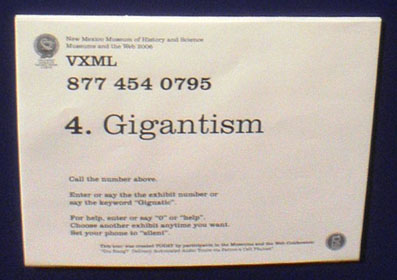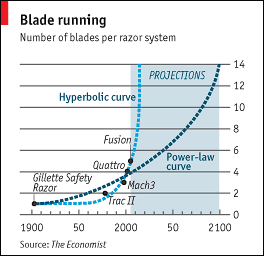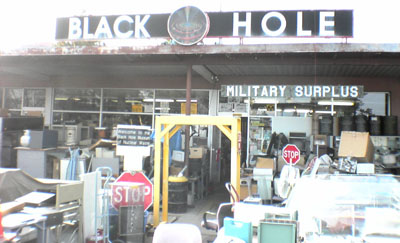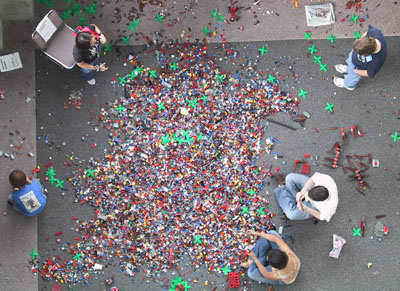The discards of Los Alamos
I’ve spent much of the past week hearing about the latest in museum technology. There were even organized outings to the museums in and around Albuquerque for us to get a gander firsthand. Strangely none of the organized tours included The Black Hole Museum of Nuclear Waste in Los Alamos.
Run for over 50 years by a guy named Edward Grothus, the museum is more like the backlot of a Mad Max film. In fact, in an irony I am certain is not lost on Grothus the place looks exactly like some archaeology dig where future humans are uncovering the remains of a once-great society’s technology after a nuclear catastrophe. He has built, in other words, that which he hopes to prevent. You might think a “museum” to the scraps of Los Alamos is some kind of reverential exercise, but there’s actually a peace theme that runs throughout, as if Grothus were hoarding all this utterly useless stuff (vials of Liquid Paper!) because he doesn’t want its bad karma let loose in the wild. Of course, it does get out; he sells it. But what sells can only be a tiny fraction, because most of the stuff you could simply stroll through Office Depot for. And it is reverential, in a way, as Grothus conducts a “Critical Mass” every Sunday in a huge A-frame “church” next door.
The technological gizmos are the most interesting for sure. All kinds of specialized and worrisome componentry sits amidst computers of bygone eras. It is like a library once-removed where you walk through wondering what documents, equations, and national security communiques issued from the teletypes and keyboards.
A fascinating museum, if ever there was one. Highly recommended. Bugs, I’m glad I took that left turn at Albuquerque.
Photo tour at Flickr.
Ghostface
Was the mask in the Scream trilogy inspired by a cave formation in Bandelier National Monument Park in New Mexico? It’s commonly held to have been inspired by Edvard Munch’s The Scream, but I’m going with the theory that Wes Craven is a hiker.

For a good time, call 877-454-0795

The annual Museums and the Web conference held its opening reception at the New Mexico Museum of Natural History in Albuquerque two nights ago. The dinosaur exhibit — which is to say, most of the museum — featured a cellphone-based tour in two flavors, keypad-activated and voice-response. All you had to do was say the number or name of the exhibit and voila! But here’s the key point: the tour itself was put together only hours earlier in a conference workshop by museum professionals, podcast-style. This is really quite revolutionary since it shows a real speed-to-market (so to speak) and flexibility of audio tours that previously had not existed. Guerrilla museum tour creation. Yet another example of the web experience for content creators and visitors infiltrating the physical museum space. Wonderful!
And don’t forget to say “Gigantism.” Not only because it triggers the audio, but because it is a lovely word.
Dayjob
I’m just back from the annual gathering of my particular tribe inside of IBM and I figured I’d take the time to tell you, loyal readers, actually what I do for a living. I’ve occasionally mentioned projects here but never actually talked about what I do. This is not because of some corporate policy. In fact, IBM’s external blogging guidelines are some of the most liberal in the industry. Many of our executives blog externally and quite candidly. Internally, blogs thrive for personal use, project teams, and professional topics.
I work for IBM’s Corporate Community Relations, a name which really doesn’t do a good job of describing our mission in the company. In a nutshell, we’re the group responsible for demonstrating innovation that matters to the world (as opposed to innovation that matters only to our company or to our customers, for example). Our programs are what might have traditionally been considered philanthropy or corporate social responsibility, but really that suggests a disconnect from the business itself. IBM Corporate Community Relations is not a function of corporate marketing but rather a group within our Innovation and Technology management line. Why is this important? Because we don’t view corporate citizenship as merely an extension of our brand. Of course, it is that in part — what you do is as much your brand as any logo or slogan — but addressing social, educational, and humanitarian problems is a lot more important than marketing. As a company of 330,000 employees in over 170 countries our “community relations” efforts have to amount to more than sponsoring the local Little League team or cutting checks to charities. Here’s a smattering of what we do.
On Demand Community – IBM’s tool for matching employees to community volunteer efforts and for preparing them with materials and training. Hours volunteered earn credit towards making a cash grant to the community organization. Amazingly successful: 60,000 employees are signed on as volunteers with over half coming from outside the US. Over 3,000,000 volunteer hours logged since the end of 2003.
Transition to Teaching – First-of-its-kind program to address the shortage of high quality math and science teachers in America. As part of the pilot IBM will pay the tuition of employees interested in leaving IBM for a career in education.
World Community Grid – Our program for solving computation-intensive projects in the life sciences. The current project FightAids@Home allows people all over the world to contribute idle processing power on their own machines to create a distributed virtual supercomputer powering the search for a cure for AIDS.
TryScience – Long-running science meta-museum with activities and virtual field trips for children and educators. Also a successful kiosk program distibuted to museums worldwide.
Web Adaptation – Project to donate accessibility technology for web users with vision and/or motor skills impairment.
KidSmart Early Learning Program – Early childhood education initiative which includes the KidSmart learning guide site and donations of Young Explorer computer systems to schools around the world.
¡TradúceloAhora! – Education-focused automatic online machine translation for English and Spanish, soon to providing instant e-mail translation.
IBM Crisis Response – Among the myriad ways IBM assisted during the Asian tsunami and US hurricane disasters of the past year, we shipped thousands of biometrically-enabled PC’s for tracking of displaced persons that tied into a system for first-responders and aid organizations to use during recovery. For Katrina, among other things, we developed the employment opportunity portal called Jobs4Recovery. Unlike many companies, IBM refused to capitalize on the public relations aspects of recovery assistance, which is why you won’t find much information about our crisis programs.
The Genographic Project – Supercool collaboration with National Geographic to map the dispersal patterns of humans out of Africa (and by extension the nature of human diversity) by analyzing the inherited mutations in indigenous peoples worldwide. Public participation is encouraged; you can swab your cheek for placement on the world migration maps. Think of it as macrogenealogy.
Eternal Egypt – Must I tell you more about this?
Well I suppose I didn’t answer the question about what I do, in particular. For the valiant few who have made it this far in a too-long post, I’ll note that I manage all the programs in CCR that relate to cultural heritage. This includes, obviously, Eternal Egypt above plus two truly exciting new projects which I can’t yet talk about but which very careful readers of this site might have an inkling about. I work with project managers, developers, and designers and of course with our partners to deliver these types of projects. It is a great gig, I have to admit, getting to work in high technology and culture at the same time.
Recently, our CEO Sam Palmisano remarked that “the world won’t look at you as a great company if all you do is make a lot of money.” I suppose you could say that the goal of my team in IBM is to make it that great company.
My goodness, you’d think I was paid to do that. What ever happened to bloggers who dish the dirt on their employers?
Less feel-good posts coming, promise.
Buddy breathing
OK, here’s an idea. How about a USB to USB gagdet that a person whose laptop battery is dying can use to suck power from someone nearby who is plugged in? Obviously you could not power a whole laptop solely from the USB draw, but the idea would be merely to replenish while there is still life left in the battery, forestalling laptop shutdown. Patent!
Scissorhands
It is safe to say that anyone who has even glanced at this blog knows that I am no luddite. I use and extol technology for its own sake all the time. And yet, and yet. There comes a time when it is so clear that neither human necessity nor technological innovation are driving change that I find myself wondering if low tech might be better. I speak of course of the proliferation of multi-bladed razors.
True to form, I’d been thinking I needed more blades for some time. Why? More blades. I had been using the prehistoric, two-blade plus lube strip Sensor Excel for years and frankly I was jealous of the three-, four-, and five- bladed variants. When they added power to vibrate the whole rig I knew it was only a matter of time. I believe the equation, check me on this, is: (r + p)b = d, where r = the basic razor stem, p = power, b = number of blades, and d = desire for object.
So I forgot my old razor on my latest trip. I was staying with my in-laws and my brother-in-law had one of the newfangled Fusion 5+1 beasts. This is the razor that the Onion actually predicted back in 2004. As the chart below from the Economist shows, the parody wasn’t all that prophetic. Blade profusion is almost as guaranteed as Moore’s Law. We’ll be at 14 blades by 2100.

My experience was terrible. See, five blades does give a nice shave on the open fields of ones cheeks, but for actual styling or for navigating any kind of variance in facial topography it is simply too big. I have a goatee, so getting close in to the beard is key. If I don’t I look like a hick meth addict festooned with different lengths of hair around my mouth. Yes, the +1 on the Fusion is the extra blade on the back precisely for this purpose, but it really doesn’t work. The single blade is still part of a gigantic bladehead and you just can’t get close enough.
I was still without a decent razor so my father-in-law bought me a powered Mach 3, a razor he swears by. Same problem and this time without the styling blade. The power too is a problem. For one, I didn’t realize how much of shaving is actually aural. I’d grown accustomed to hearing the sound of the beard growth being severed or not — no shearing noise meaning I’d gotten that area fully. This is much harder to do with a vibrating shaft (ahem) in your hand. I found it taking me longer to shave. Maybe I was also more cautious since it felt like the razor would vibrate right out of my hand at any time. There’s enough metal on that baby to earn its place in a display case next to a cat-o’-nine-tails mace.
So, I’m going low-tech. Back to the Sensor Excel. Perhaps nanotech is the salvation here and I will return to the multibladed progress curve, but for now I’m bailing. Call me backwards. But also call me well-groomed.
View > Show > Grid
The Palace of Supreme Harmony at the Forbidden City in Beijing under renovation. The pace and quality of the upgrade is staggering.
See also my helpful guide to Chinese toilet iconography on Flickr.
South by
The Interactive portion of the venerable culture festival known as South by Southwest concluded this week. I was there for much of it before departing for a somewhat hellish two days in Beijing (“East by Far East “). The event was one nerdgasm after the next. “Digital creatives” from all around crowded panels, keynotes, and the hallways to suckle the free wifi and listen to how They Too Could Be Web 2.0 or how they could design the next community app. In fact the conference was a great example of a community simultaneously inhabiting the virtual and physical realms. Attendees in the audience chatted in giant IRC rooms that corresponded to the individual panels often with the speakers on the platform chiming in backchannel or replying in the real world. As this was my first SXSW I can’t compare to previous events, but people told me this time it was more entrepreneurial in flavor, less tools-based. Sure, there were panels on CSS, but mostly topics were on community and startups or abstract concepts like convergence, a buzzword on which I blathered.
The best part by far of course was meeting people. Networking and beer-drinking is built right into the conference proceedings. You have to love that after-event parties are listed in the program. And attendees were genuinely interested in talking. You never quite knew who you’d be standing next to. Chances were high he or she had just sold a company to Yahoo or Google, but you know, so what? So might you soon. The Austin tech scene was well represented. So was the Chicago scene, such as there is one — and that pleased me. Chicago design mavens Jim Coudal of Coudal Partners and Jason Fried of 37Signals delivered the opening keynote and basically entreated the crowd to drop complexity, focus on creative entrepreneurship and then wait for the money to pour in. The crew from Threadless was there too, a great example of doing just that. (Maybe there’s a chance for a Chicago company-funded party next year along the lines of Seattle’s South by Northwest bash? South by Midwest?)
As a guy from IBM, perhaps the former paragon of complexity, I was pleased to be mostly taken on my own merits. It usually doesn’t happen that way. There’s a kind of stigma of respect when I normally tell people I work for the ‘BM. It is almost always positive, mind you, but the fact I work for IBM often overpowers anything I might offer individually. Not at SXSW. People didn’t much give a shit. I liked that. Hell, Craig Newmark of craigslist told me he worked for IBM for 17 years prior to quietly changing the world. See there’s hope.
OK, no more compass puns. That’s my direction anyway. Oh god, jetlag delirium.
Verge
Sitting in an afternoon panel at SxSW today I started a post on how I thought my panel in the morning went. I was thinking, gee, it would be nice to have a transcript when I looked up – literally to the guy sitting in front of me – and goddamn but he had one up on his screen.* I asked where he got it. He said, “Oh this is my site. I type fast.” And that is the essence of SxSW.
My panel? Oh it was on a concept that I didn’t really agree with. In fact, neither did my co-panelsts, David Pescovitz of Boing Boing and David-Michel Davies of the Webby Awards. Standing in line as we waited for our credentials a staffer looked at the title of our panel “Convergence and Transformation: A Whole New Creative World” and said quite disdainfully “What in the hell is that?” I shrugged. Sometimes that’s the best panel to be on though.
It was actually a lively discussion. The consensus from the panel was that it is not technology that is converging – tools diverge and proliferate to suit new tasks, after all – but that there is such a thing as convergent experience and in fact human beings crave experiences that unite, filter, and simplify – the more so in the face of multiplying tools, features, and media.
My particular take on the issue was to suggest that designers draw lessons from evolutionary biology. At the species level and above life does not converge at all. And in the rare case that it does – as with the horse and the donkey – it yields infertile life forms. There’s no convergence below the species level either, but there is certainly recombination, genetic in this case, which you might think of as a simultaneous divergence and convergence. A philosophy of recombinant design, I offered, is one where experiences are allowed to emerge by virtue of the remixability of your offering. Or, put differently, recombinant design is design as if your goal was to make designers of your customers. Consumer-as-producer, DIY media. Not terribly novel, I admit, but then no one threw me off the dais either.
[*} Not verbatim. I talked a lot more and made a lot less sense in reality.
















